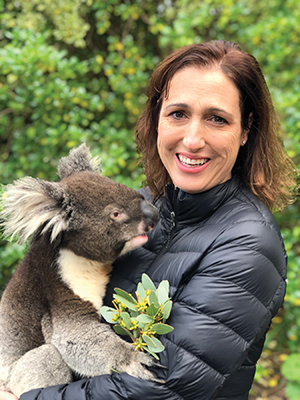Lung Cancer Survivor
Finding The Silver Linings in an Advanced Lung Cancer Diagnosis
 In 2015, at 40 years old, Laura Greco was diagnosed with
In 2015, at 40 years old, Laura Greco was diagnosed with
Stage IV non-small cell lung cancer. To say it’s changed her
life is an understatement, but treatment that targets her unique genomic mutations is enabling her to live her life to the fullest.
My husband and I took our two sons on a month-long, cross-country road trip and hiked in national parks. I traveled to Australia and held a koala. We renewed our wedding vows in Hawaii. I even skied. And all of that has happened since I was diagnosed with lung cancer. How have I been able to have such wonderful experiences? I believe it’s a combination of collaboration with my medical team, advances in my treatment plan and staying focused on enjoying life.
I was 40 years old when I was diagnosed with Stage IIIA
non-small cell lung cancer. I had no risk factors. My doctor said,
“I bet you have a genetic marker,” so I went to a well-known
cancer center to find out. Genomic testing results revealed I had two cancer cell mutations: ALK+ and MET amplification.
My doctor explained that a type of targeted therapy called
tyrosine kinase inhibitors (TKIs) could target the ALK+ mutation, but they weren’t considered curative. At Stage IIIA, the goal is to cure. I had the standard-of-care treatment of chemotherapy and radiation therapy followed by surgery. The thought was to keep the TKIs in our back pocket in case we needed them. As it turned out, we did.
Not long after completing that course of treatment, the cancer metastasized to my brain. My goals of treatment changed. Though the cancer was no longer curable, that Stage IV diagnosis made me eligible for a TKI. I began taking an ALK inhibitor that blocks the abnormal ALK protein responsible for the metastasis.
Initial follow-up results showed a 50 percent reduction in my lung and brain tumors. Even better, the next ones showed a 75 percent reduction. But when my liver enzymes became too elevated, I took a six-week hiatus from the drug. My doctor adjusted the dosage, and I resumed treatment.
More than a year later, we saw evidence the drug wasn’t working as well as it had been. My doctor increased the dosage and prescribed radiation therapy. More than a year after the completion of my radiation therapy, fluid built up in my brain. During brain surgery to relieve the pressure, the surgeon found a new tumor that wasn’t visible before. It was removed, biopsied and genomic testing was done on it. Although we saw some level of MET amplification when I was originally diagnosed, the level was now 25 — the highest it goes.
By this time, I’d been on the ALK inhibitor for three years. The MET amplification made me a candidate for a certain MET inhibitor. However, that drug didn’t penetrate the brain well. My doctor suggested a drug that would target the MET exon 14 skipping mutation and the MET amplification. No one had ever taken it with the ALK inhibitor before. I became the first to take it in combination after being granted compassionate use, also called expanded access.
The combination therapy (12 pills a day) works well. When my treatment plan needs to change, I know I have options. I’d take a targeted therapy a thousand times over a chemotherapy. With chemotherapy, I was very fatigued and nauseated and lost my hair. Targeted therapies aren’t without side effects, but mine are manageable. They give me more freedom, and I am committed to squeezing the most I can out of life.
Once you’re in the cancer world, you quickly learn nothing is written in stone. It’s not an orderly world where doctors have all the answers. That’s not all bad because it emphasizes the importance of being an educated patient. Learn about your type of cancer and the available treatment options while your treatment is working. That will prepare you for what to do if the drug runs its course, which it almost always will. You don’t want to feel pressured to make important decisions — you want to have options ready.
I left my career as an attorney to focus on myself and my family. Our boys were just two and six when I was diagnosed. It hasn’t been the easiest ride, but they are learning to deal with adversity and how to make positive change. They take part in advocacy walks and host lemonade stands to fundraise for lung cancer research. As a college professor, my husband has a fairly flexible schedule, and we’ve taken amazing trips. This diagnosis is now part of our family story. Though I’d give it back in a heartbeat, I’m thankful for these silver linings.


